Create Amazing Personalized Video Greeting Cards



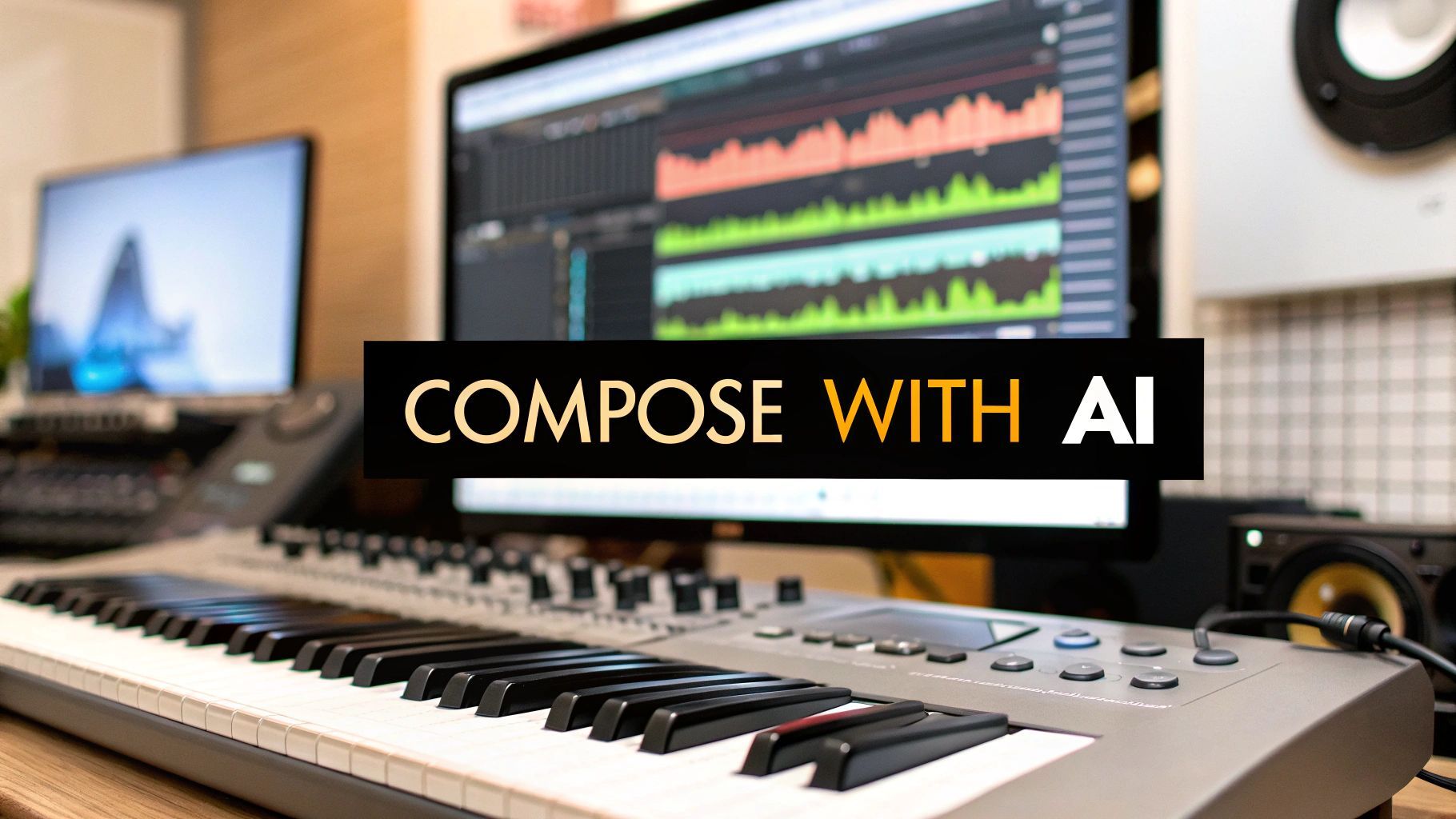
Want to create music with AI? This guide walks you through composing, producing, and mastering original tracks using powerful and intuitive AI music tools.
Ever wondered if you could create music with AI? The answer is a resounding yes. We're talking about specialized tools that can spin simple text descriptions into full-blown musical pieces, from a single guitar riff to a complete, multi-layered song. Think of these platforms as your new creative partner, one that handles the heavy lifting of music theory so you can stay focused on your artistic vision—no pricey gear or formal training required.
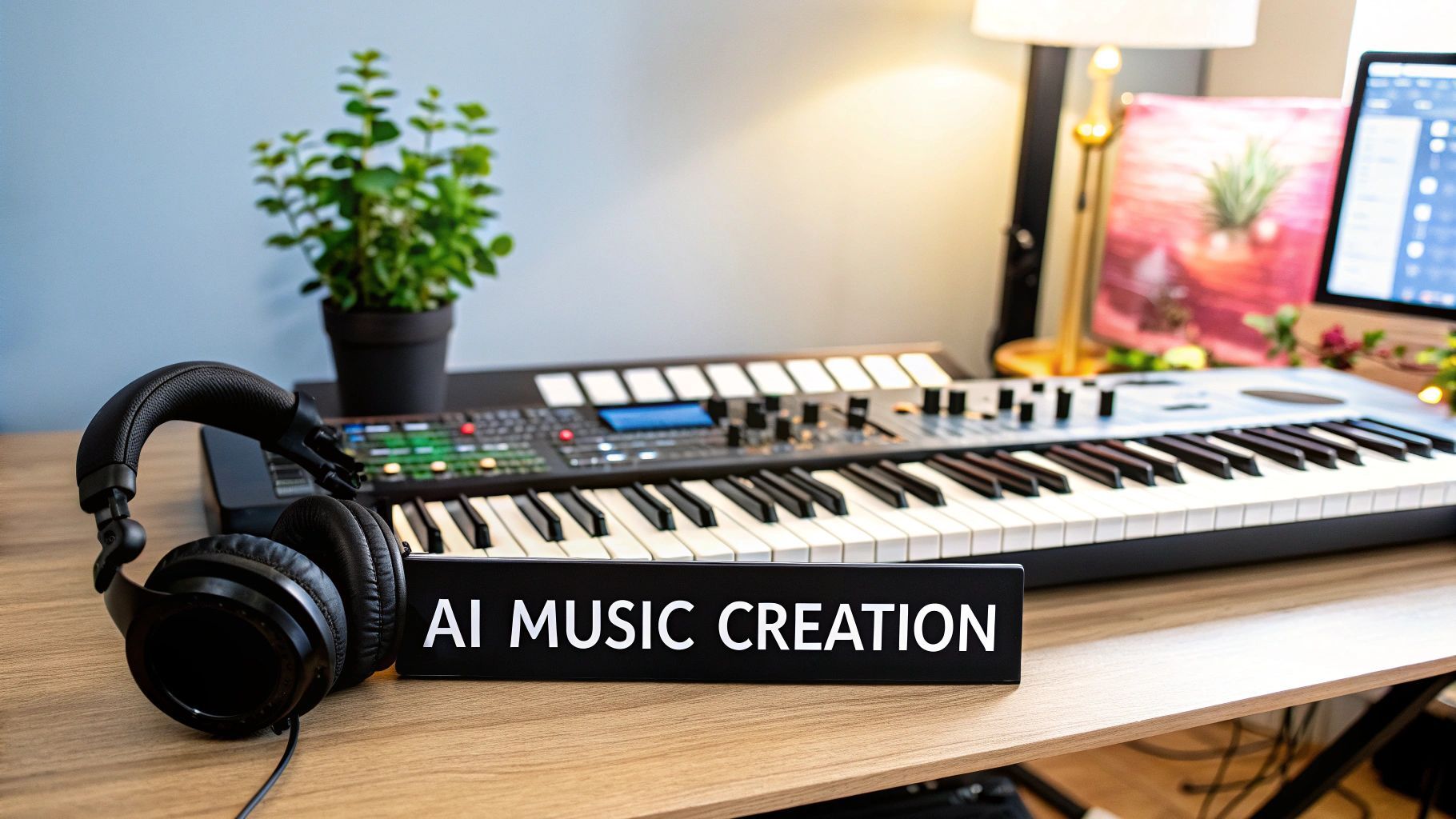
Get ready, because we're stepping into a wild new era of music-making where your imagination is the only real bottleneck. All those old gatekeeping rules? The ones that said you needed years of theory lessons or a studio packed with expensive synths? Toss them out. AI music generation is blowing the doors wide open for everyone, whether you're a seasoned producer looking to break a creative block or just a curious newcomer who wants to make some noise.
This isn't about handing your creativity over to a robot. It's about getting a massive boost. Picture an AI as your ultimate collaborator—an tireless assistant ready to spit out a dozen different drum patterns or a fresh chord progression on command, helping you bring your ideas to life at lightning speed.
The thought of a machine composing music might feel a little sterile, but the reality is way more collaborative and, frankly, more fun. These tools are designed to follow your lead. You're still the director, the one calling the shots on the mood and style. The AI is just there to execute the technical stuff, freeing you up to think about the feel and the story you want to tell.
Let's bust a myth right now: AI isn't here to replace artists. It’s a powerful new instrument, just like the synthesizer or the drum machine was for previous generations. It's another tool in the toolkit.
This whole shift is making music creation more accessible than ever before. It's knocking down some of the biggest hurdles that used to stop people from even starting.
Cost: Forget dropping thousands on software and hardware just to get your foot in the door. Skill: You don't need to be a piano virtuoso or a sound engineering wizard anymore. Time: Why spend hours stuck on a chord progression when you can generate solid starting points in minutes? Your workflow just got a serious upgrade.
This creative explosion isn't happening in a vacuum. The technology has finally matured to a point where it can deliver on its promises. Thanks to huge leaps in machine learning, AI models can now grasp the nuances of music—not just notes and rhythms, but also mood, texture, and the unwritten rules of different genres. It's this sophistication that's fueling the insane growth in the AI music generation market.
Speaking of growth, the market is on track to hit around $576 million by 2025, growing at a blistering pace of about 30.5% annually. This boom is being driven by everyone from bedroom producers looking for inspiration to major companies needing music for games, ads, and films. If you want to dive deeper, you can explore more about this financial trend and what it means for the future of creative work.
The real magic behind making music with AI isn't buried in some complicated software menu; it’s all in the words you choose. A truly great prompt is like handing a detailed blueprint to a brilliant, lightning-fast musician. Once you move past simple commands like "sad piano song," you start to unlock what these tools can really do.
Think of yourself as a film director. You wouldn't just tell an actor to "be sad." You’d give them the backstory, the motivation, the entire scene. The same exact principle applies here. Specificity is your secret weapon.
Let's get practical. Instead of asking for an "upbeat pop track," try painting the whole picture. Who's listening to this song? Where are they? What do you want them to feel? Diving into that level of detail is what guides the AI to pull the sound right out of your head. The more descriptive you are, the better the music will be.
It's a skill that pays off across all kinds of creative AI. In fact, learning about crafting effective prompts for AI in writing can make you a better AI musician. The core concept is identical: steer the machine with rich, specific language.
This next image breaks down just how much AI can speed up the nuts and bolts of composition compared to doing it all the old-fashioned way.
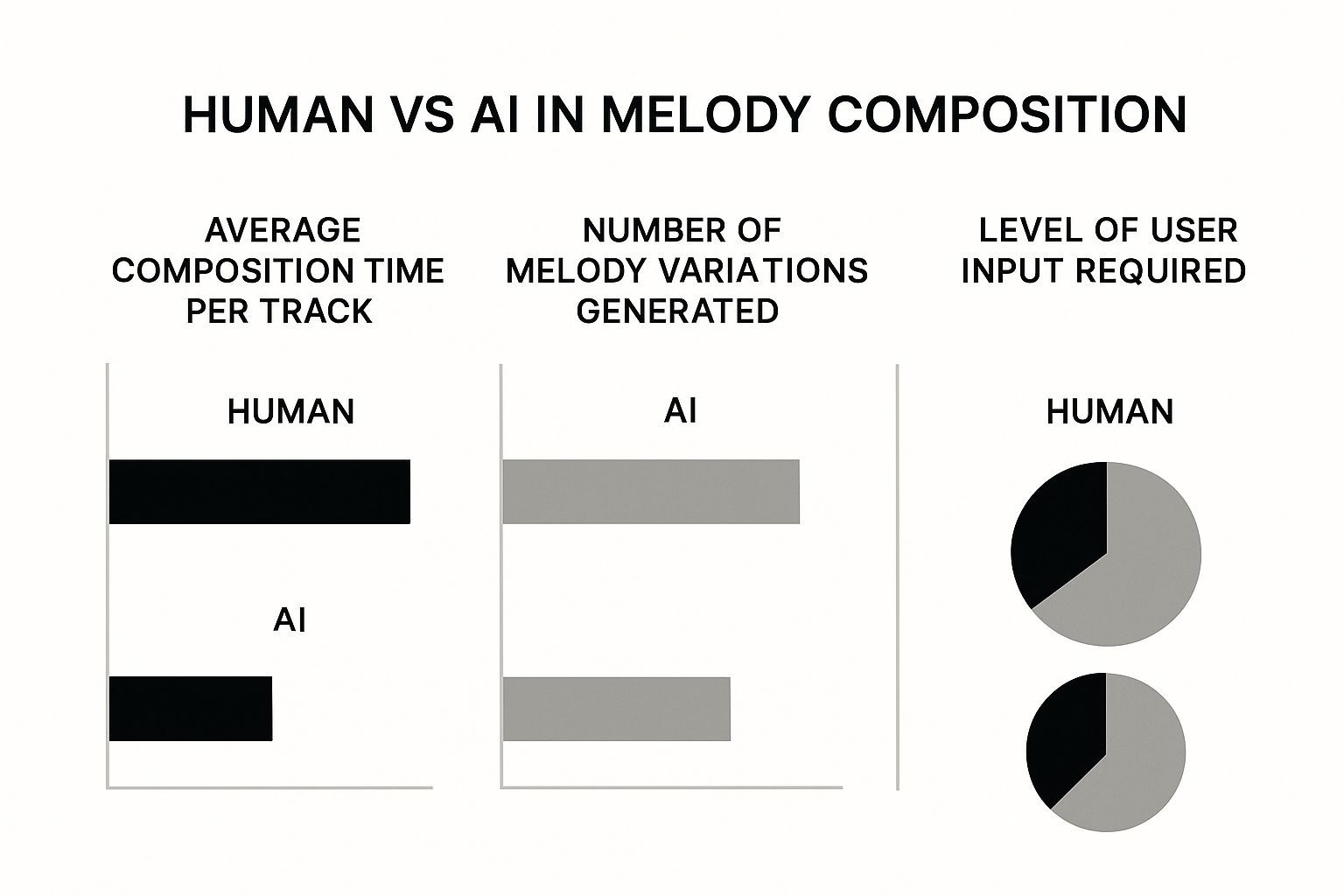
As you can see, your vision is still the most important ingredient. But AI can be an incredible partner, drastically cutting down composition time and letting you explore countless creative variations you might not have discovered otherwise.
Let's look at what this means in practice. A vague prompt gets you a generic result, while a detailed one gets you something unique. The table below shows just how big the difference is.
| Desired Outcome | Basic Prompt (Generic Result) | Advanced Prompt (Specific Result) |
|---|---|---|
| Desert Road Trip | Driving rock song | An indie rock track with a dusty, vintage feel. Features a driving bassline, a simple but tight drum beat at 120 BPM, and a shimmering, delayed electric guitar melody. Think sunset on an open highway in the American Southwest. No vocals. |
See the difference? The advanced prompt paints a complete picture. It nails the genre, mood, instruments, tempo (120 BPM), and even the texture ("dusty"). That kind of detailed map leaves far less to chance and gives the AI a clear path to follow.
Pro Tip: Get weird with it! Some of the coolest sounds come from mashing up unexpected genres. Try asking for "lo-fi hip-hop with celtic harp melodies" or "a cinematic orchestral score with 80s synth-pop drums." Don't be afraid to experiment.
This approach isn't just a niche trick anymore. It’s becoming the new standard. Already, over 60% of musicians say they use AI to help write and edit their songs. And audiences are along for the ride—studies show a whopping 82% of people can't tell the difference between music made by AI and tracks made by humans.
Ready to take your creativity to another level? You can use these same prompting skills to completely reimagine existing songs. Our guide on how to https://sendfame.com/ai-music-remix will show you exactly how to get started.
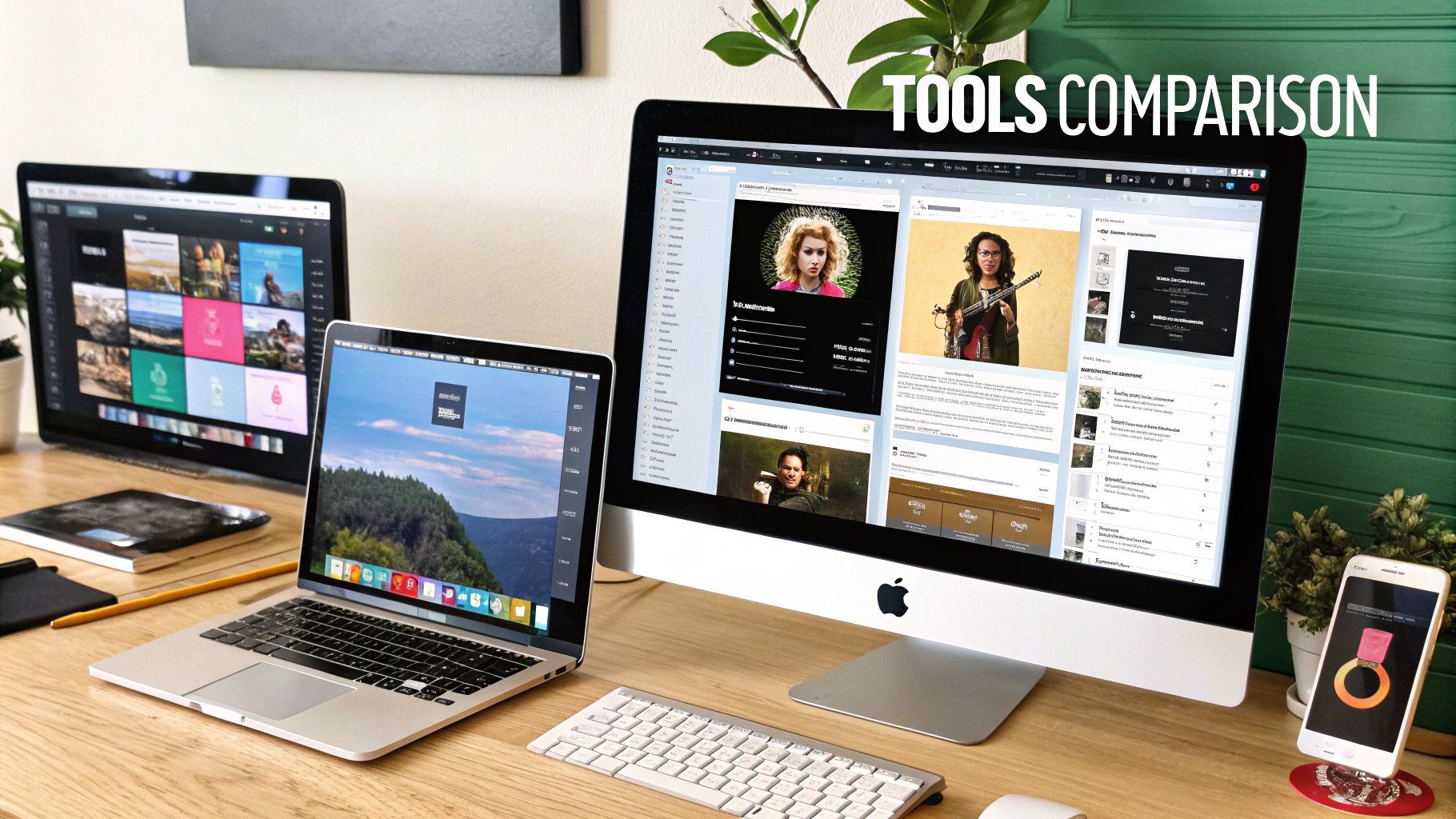
Alright, you’ve wrestled with the AI and wrangled a killer musical idea—maybe a melody you can’t get out of your head or a chord progression that just hits right. Awesome. Now comes the real magic: turning that spark into a fully-fleshed-out song. It’s time to put on your producer hat and assemble your AI-powered band, piece by piece.
Think of it like building anything great. Just as a project needs a clear plan for understanding development stages, a song needs a thoughtful, layered approach. This is how you avoid a cluttered, muddy mess and make sure every sound has a job to do.
Every banger needs a solid backbone. For just about any music you hear today, that means starting with the rhythm section: the drums and the bass. These two are the engine room of your track, working together to create the groove that makes people move.
Let's say we're cooking up a synthwave track. You've already got that moody, nostalgic chord progression. The very next thing you need is a beat that matches that vibe. A specific, detailed prompt is your best friend here. Try something like: "Generate a tight, punchy 80s drum machine beat at 110 BPM with a heavy gated reverb snare on beats 2 and 4."
Got a drum loop you're digging? Perfect. Now, let's get that bassline in there to lock it all down. You want it to hug the drums tightly. A good prompt would be: "Create a simple, pulsing synth bassline in the key of C minor that locks in perfectly with the previous drum beat. The bass should play steady eighth notes to create a driving feel."
By nailing the rhythm section first, you’re setting the song's heartbeat. This creates a sturdy frame, making it a thousand times easier to stack melodic and atmospheric parts on top without the whole thing falling apart.
With a solid groove bumping away, the fun really begins. Now you get to paint with sound, adding all the layers that give the song its harmonic richness and emotional character.
Take a step back and listen. What does the track need? If it feels a bit bare, maybe some lush, atmospheric pads will fill it out. You could prompt the AI with: "Generate a warm, evolving analog synth pad playing the C minor chord progression. Add a slow filter sweep to give it gentle movement and a dreamy texture."
Now for the ear candy—those little melodic hooks and textures that get stuck in people's heads. This is where you can get really creative.
Arpeggios: Ask for something specific like, "A fast, shimmering 16th-note arpeggio that follows the chord changes." Lead Lines: Try prompting, "A soaring, emotive lead synthesizer melody with a lot of vibrato." Sound Effects: Even a simple, "Add subtle futuristic sci-fi sound effects and risers at key transition points" can make a huge difference.
This layering technique is a secret weapon for producers everywhere. It’s a core concept that applies to everything from crafting original music to putting a new spin on a classic. If you're curious about how these same principles work for remixing, our guide on how to make AI music covers has some fantastic pointers.
So, your AI just spat out a track. It’s technically flawless—every note snapped to the grid, every sound crystal clear. But something's... off. It feels sterile, a little robotic, and just too perfect. Now comes the most important part of the process, where you step in to breathe some actual life into the machine’s creation.
This is where your artistry takes over. We're about to transform a mathematically correct sequence of notes into something that feels genuinely human. The secret isn't some complex production wizardry; it's all about introducing those tiny, perfect imperfections that make music feel alive.
Your first move is to export the individual instrument tracks (producers call these stems) from your AI tool. Then, you'll pull them into a Digital Audio Workstation, or DAW. Don't let the acronym intimidate you. Fantastic, user-friendly options like GarageBand (which is free for Apple users) or Ableton Live are built for exactly this kind of creative work.
Once you have your stems loaded up on separate tracks in your DAW, you become the conductor. This is where you get to nudge, tweak, and polish the composition until it has that elusive human groove. You’re not trying to rewrite the song; you’re just coaching the performance.
A great place to start is with the timing. An AI almost always places every single drum hit perfectly on the beat. Humans, well, we don't. Try grabbing a single snare hit or a kick drum and dragging it just a few milliseconds behind or ahead of the grid. It’s a tiny adjustment, but it can instantly make a stiff beat feel more relaxed and natural.
Next, let's mess with the velocity, which is basically how hard or soft a note is played. A real pianist never hits every key with the exact same force, and that’s where the emotion comes from.
Vary Your Velocities: Dive into the MIDI track for your piano or synth and start randomizing the velocities a bit. In a chord, make some notes a little louder and others a touch softer. It immediately sounds more authentic. Emphasize the Important Stuff: Find the main notes in your melody and give them a slight velocity boost. Making them just a touch louder than the surrounding notes gives them more emotional weight and makes them pop.
You can apply this same thinking to volume automation. A mix where everything stays at the same volume is a boring mix. Use your DAW’s automation tools to draw in subtle volume changes over time.
Try making the chorus just 1-2 decibels louder than the verse. It’s a classic trick that creates a sense of lift and excitement. You could also have a background synth pad slowly fade in and out to build a little tension. These small dynamic shifts are what make a track breathe.
Want the single most effective way to make your AI track undeniably yours? Add something organic that you recorded yourself. It doesn't have to be a mind-blowing guitar solo or a perfectly pitched vocal run. In fact, simple is often way better.
Give these a shot:
A Simple Shaker: Grab your phone, record yourself shaking a set of keys or a bottle of rice, and layer that little percussion loop into your drum beat. A Vocal Harmony: Seriously, you don’t need to be a professional singer. A simple “ooh” or “aah” harmony, tucked way down in the mix, can add an incredible amount of warmth. A Real Instrument: If you play anything at all—even at a super basic level—record a simple line to layer on top. A single, real guitar chord strummed over an AI synth pad can completely transform the vibe of a track.
By blending the AI’s number-crunching power with your own creative, human touch, you really do get the best of both worlds. You're starting a song with AI, but you’re finishing it with heart.
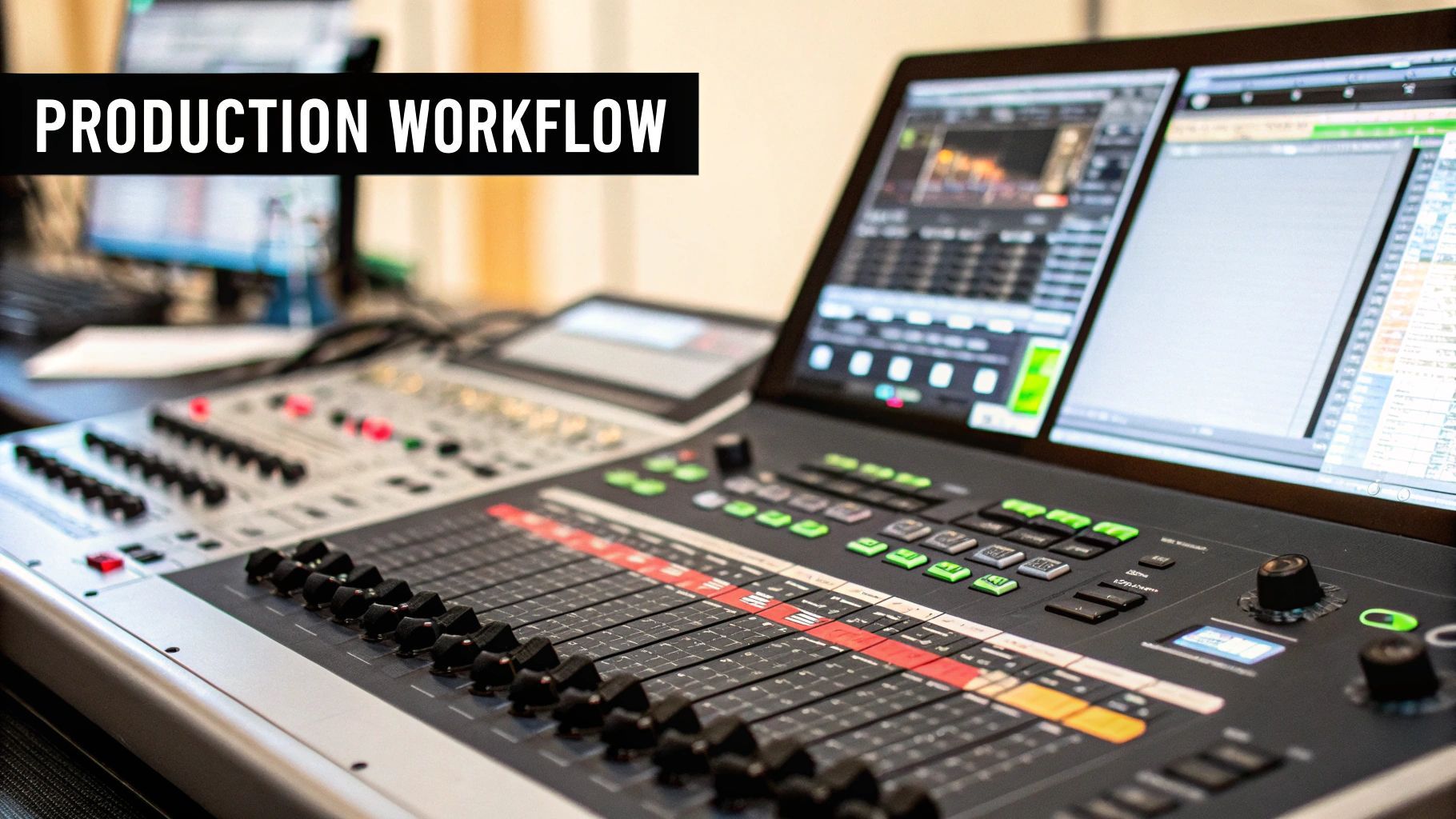
You’ve done it. After all the prompting, layering, and tweaking, you have a finished song. But before you unleash it on the world, there's one final, make-or-break step that separates the demos from the professional releases: mastering.
Mastering is that final coat of polish that makes your song pop. It’s what ensures your track sounds incredible everywhere, from cheap earbuds to a booming club system. This used to be a dark art, a mysterious process reserved for engineers in expensive studios, but AI has blown the doors wide open.
Think of AI mastering as your personal audio engineer, ready to go in seconds. These platforms can listen to your mix and apply the perfect cocktail of equalization, compression, and limiting to make it shine. A track that sounds a bit quiet or muddy can suddenly sound wide, loud, and full of life.
It's a pretty wild experience. You upload your mix, and in just a few minutes, you get back a version that’s ready for Spotify. The difference can be night and day. It’s that final touch that makes your music sound truly complete.
The real goal of mastering isn't just to make your song loud; it's to make it translate. A great master ensures the emotional impact you worked so hard to create is felt by the listener, no matter what device they're using.
When you've used AI for the entire creative process, finishing with an AI mastering tool just makes sense. It keeps everything moving quickly, letting you get a radio-ready sound without ever having to touch a complex plugin. You can learn more about how our own https://sendfame.com/ai-music-generator helps keep this whole workflow seamless.
Once your track is mastered, it's finally ready for an audience. But now you have to think about file formats and sizes. You'll often need to shrink your audio files for easy sharing or storage, and learning how to properly compress audio files without losing quality is a crucial skill for any modern artist.
And let's not forget the business side of things. The financial impact here is staggering. The global AI in music market is on a trajectory to explode from $3.9 billion in 2024 to a jaw-dropping $38.7 billion by 2033.
What does that mean for you? AI-generated music is projected to bump up the entire music industry's revenue by 17.2% by 2025, opening up brand-new ways for creators to earn a living. Keeping an eye on these trends helps you get in on the ground floor as new business models pop up around this tech.
Jumping into AI music creation is a blast, but let's be real—it's a new frontier, and you probably have some questions. It's totally normal. Think of me as your guide who's already tripped over a few cables and figured a few things out. Let's tackle some of the biggest head-scratchers so you can start making music with confidence.
This is the million-dollar question, isn't it? The short answer is yes, but the long answer is, "it depends on how much you put into it."
If you just type "sad piano ballad" and try to sell the raw file the AI spits out, you're on shaky ground, legally speaking. Copyright law loves human creativity. So, the more you treat the AI as a co-writer instead of the entire band, the stronger your ownership claim becomes.
Think of it this way:
Use the AI to generate a cool chord progression. Then, you fire up your DAW, rearrange the structure, and add your own bassline. You lay down some vocals or chop up the AI-generated melody into something new.
Now that's a track you have a much stronger claim to. Always, and I mean always, check the terms of service for the specific AI tool you're using. Some give you full commercial rights, no strings attached, while others are for personal use only. Do your homework before you plan that album launch.
My two cents: The more of your own creative DNA you mix into the track, the more it's truly yours. AI is the spark, but you're still the artist.
Nope. Not even a little bit. And honestly, that’s the magic of it.
These tools are built to handle all the complicated stuff—the circle of fifths, the chord inversions, the modal interchanges—so you don't have to. You get to be the director, focusing on the vibe. Your job is to describe the feeling: "a nostalgic, rainy-day lo-fi beat" or "an epic, heroic orchestral score for a final battle."
The AI translates your creative vision into notes and chords that actually work together. While knowing a bit of theory can help you write more specific prompts ("use a I-V-vi-IV progression in C major"), it's absolutely not a requirement to get started. You bring the ideas; the AI brings the theory.
When you're just starting, you want something that's more fun than frustrating. You need a tool that lets you get your hands dirty and hear results fast, without needing to read a massive manual.
For anyone brand new to the scene, I'd point you toward platforms like Suno or Soundraw. They're fantastic because you can go from a simple text idea to a full song in seconds. It’s the perfect way to experiment and see what's possible.
Once you get the hang of it and find yourself wanting more knobs to turn and sliders to push, you can explore more advanced options like AIVA or Amper Music. For a super deep dive into all the pros and cons, check out our guide on the best AI music generators in 2025.
Ah, the "AI sound." The biggest giveaway is using the first thing the generator gives you. The secret to making unique music is to never take that first draft as the final product. Personalization is everything.
Here are a few tricks I use all the time:
Mash-Up Your Prompts: Don't be afraid to get weird. Ask for "Tibetan monk chants over a Chicago house beat" or "a bluegrass banjo line with a dreamy synth pad." The more unexpected the combination, the more original the result. Layer and Combine: Generate a few different drum loops. Generate a couple of basslines. Drag them all into your DAW and see what sticks. Sometimes the best ideas come from happy accidents. Add a Human Touch: This is the big one. Record yourself humming a simple harmony, tapping on your desk for percussion, or playing a single, simple keyboard chord. Just one organic element can breathe life into an entire AI track. Process and Mix: Export the stems (the individual instrument tracks) and go wild with effects. Add reverb, delay, EQ, or a cool flanger. Chop up the melody and rearrange it. This is where you really make it your own.
Ready to stop wondering and start creating? With SendFame, you can generate your own original music, create eye-popping videos, and even get custom shoutouts from AI celebrities. It all happens in just a few clicks. Dive in and see what you can cook up at https://sendfame.com.
Create Epic
SendFame